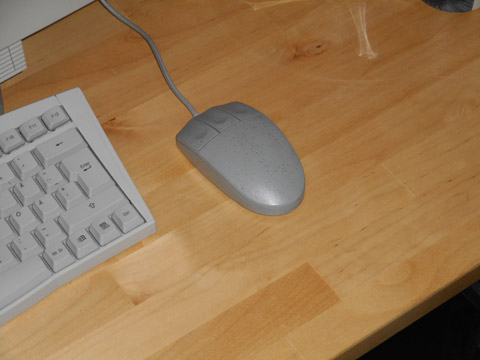
"Silicon Graphics granite PS/2 mouse" is a to my knowledge unambiguous
way of referring to the mouse that was included with some Silicon
Graphics (SGI) UNIX workstations in the 1990s, such as the Indigo2.
In contrast to earlier Silicon Graphics mice, it is compatible with
PS/2 and thus easily usable with modern PCs. It is apparently a
rebranded Logitech Pilot Mouse.
The mouse makes a good first impression. It has a simply stunning appearance. For an input device from the 90s, it has a darker-than-usual gray color, with little black (or dark blue?) dots scattered across the surface. If nothing else, this mouse is worth a purchase only because of the design.
Almost as strikingly, at least for the modern PC user, the mouse has three buttons! The middle mouse click functions in the same way as the today more common scroll-wheel click, but it is much more easily performed. This is a huge advantage in user interfaces that rely heavily on the middle mouse button, such as Plan 9 and to some extent X11. It may also be useful in some PC games.
This means that the mouse doesn't have a scroll wheel, although many
Windows applications support scrolling by clicking or holding the
middle mouse button and then dragging the mouse. (And I personally have
a love–hate relationship with scroll wheels, as – while they are very
useful – I tend to compulsively fidget with them. A three-button mouse
turns out to be a good compromise.) Another consequence of the three-button design is that the mouse requires a slightly
different hand position. I was able to adjust in
only a couple of minutes, though.
It is a ball mouse, which comes with both benefits and drawbacks – drawbacks primarily. While, in my opinion, ball mice tend for some reason to be a bit easier to control at a high sensitivity, they are in almost every aspect inferior to optical and laser mice. That is not to say that they're bad; when I'm not playing PC games, I almost exclusively use ball mice.
In terms of construction, it seems rather well-built. The mouse buttons are very solid, not flimsy at all, and have a deep, defined, satisfying sound. I would say, however, that they almost require a bit too much force to click, but only almost. The only real problem I can see with the construction is that the mouse creaks when pressed in certain ways, and this does make it a bit less pleasant to use. It is not a loud noise, but it's enough to occasionally annoy me.
Furthermore, the rubber pads on mine don't provide much friction on
a wooden desk. The cable tends to "tug" on the mouse, making it slide
back, if I place it in certain positions.
Overall, I recommend this mouse, but I would
recommend it even more highly if the plastic didn't break and if the
rubber pads were better. In terms of appearance, though, it's
unparalleled.
Last updated on 4 Jan 2021.
© 2020–2021 John Ankarström. Up
Comments • Submit